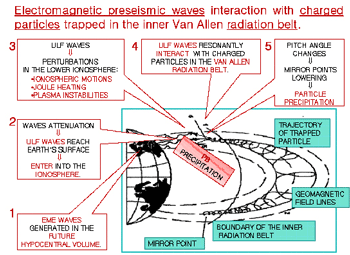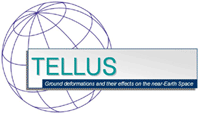The Experiment
The experiment consists in performing measurements of aseismic fault creep strains at LNGS to be reconciled with the preparation of local earthquakes. In the last years a space project has been developed to accompany ground-based measurements with space investigations to be carried out in the near-Earth space (ionosphere-magnetosphere transition zone).
Ground-based measurements are performed by three bi-axial TILTMETERS located at LNGS and space observations by multi-instrument payloads installed on board of LEO satellites.
Ground-Based Measurements
Figure 1 shows two-component-tiltmeters with relative analog detecting and digital acquisition systems. Tilt sensors consist of horizontal-pendulum tiltmeters with Zöllner bifilar suspension made in super Invar. The analog detecting system is composed of an infrared laser beam and a 1024-photodiodes linear array of 0.5 inch long. The resolution is 0.05 mrad. The digital acquisition system allows the tilt data to be collected hourly.

Figure 1. Ground tilt station consisting of two-component-horizontal-pendulum tiltmeters with Zöllner bifilar suspension, analog detecting and digital acquisition systems.
An example of aseismic fault creep episodes associated with earthquakes is reported in figure 2. In the left side of the figure daily averaged tilt component data from the four PES, AQU, GRS, and STI sites of the Central Apennines (Italy), detrended by meteorological (mainly thermoelastic) seasonal components and linear secular effects of tectonic origin, revealed intermediate-term tilts of a few months as possible precursors of the seismic sequence occurred in the Umbria-Marches region during 1997. Two main shocks with magnitude Mw = 5.7 and Mw = 6.0 occurred on September 26, 1997 at 00:33 and 9:40 UTC, respectively, at Colfiorito Village. Focal mechanisms for the two shocks reveal normal faulting and results of the moment tensor analysis give strike 152° and 143° , dip 46° and 36°, rake -83° and -86°, respectively. The GRS pre-earthquake signal of figure 2 (top) has been recorded at LNGS. The observed intermediate-term preseismic tilts are considered as the manifestation of aseismic creep episodes in the fault materials close to the tilt sites. The onset times of such precursory signals show a time delay relatively to each other and the different onset times are observed at different distances from the same earthquake. In particular, the onset times observed at each tilt site appear to increase with increasing distance of such site from the epicentral area. At greatest distances, where the preseismic strain becomes negligible (STI recording), the characteristic intermediate-term ground tilts vanish completely. All these evidences seems to indicate the existence of a strain field slowly (~1cm/s) propagating from the dilatancy (focal) area to the tiltmeters, through rigid crustal blocks separated by weak transition zones with viscoelastic rheology. This propagation is thought to be the cause of the local aseismic fault slip episodes recorded by tiltmeters. As a confirmation, a best fitting carried out on the data by a creep function from the Kelvin-Voigt viscoelastic model (figure 2, top right) demonstrates that these signals may be considered as fault creep events. Also a specific crust block modelling has been proposed, which justifies the observations (figure 2, down right).

Figure 2. Aseismic fault creep episodes detected at LNGS and associated with earthquakes within the TELLUS experiment. A Kelvin-Voigt viscoelastic model has been applied to data and a crustal block modelling has been proposed to justify the results in the central Apennines area.
In addition to the tiltmeters, an original two-frequency electromagnetic strainmeter was designed and constructed for wide base-length and high-resolution ground-based strain measurements.
Space-Based Observations
Recent observations demonstrate that precursory phenomena of earthquakes, and in particular electromagnetic emissions in the ULF- HF frequency band (from ~DC to ~MHz), propagate from the Earth's surface, perturb the surrounding medium and can reach large distances up to the so-called topside ionosphere (ionosphere-magnetosphere transition zone), with consequent perturbations and instabilities in the ionospheric plasma. To ionospheric perturbations also contribute trapped particle precipitations from the Van Allen radiation belt induced by wave-particle interactions. An oversimplified scheme of the phenomena is reported as follows:

To investigate these phenomena the use of LEO satellites with a multi-instrument payload revealed to be an appropriate solution.
On board the satellite ULF, ELF, VLF, HF electromagnetic fields, high-energy (up to a few hundred MeV) charged particle fluxes, and ionospheric plasma parameters (density, velocity and temperature of both the electronic and ionic components), are detected and simultaneous ground-based measurements of mechanical and electromagnetic fields are carried out in several test areas, including the Central Apennines where an instrumental network is operational. The LNGS tilt site is a node of this network.
The plan of the scientific space payload, which includes scalar and vector magnetometers, several electric probes, a particle detector, and plasma detectors (Langmuir probe, retarding potential analyser, and plasma driftmeter), also suggested the design and construction of original instruments, which gave rise to several patents.
In the following, is given a short information about the ESPERIA project and a few instruments of its payload (magnetometer EGLE and particle detectors LAZIO and ARINA), which have been constructed and tested in space. Also characteristics of the DEMETER French space mission (of which the TELLUS team is guest investigator) are briefly reported.
1. The ESPERIA space project.
Figure 3 shows the ESPERIA satellite configuration resulting from the ASI phase A study.

Figure 3. [left] Schematic external view of the ESPERIA satellite with deployed booms and relative systems of antennas for electric and magnetic field measurements (EFA/MAFA). The particle detector PDA (double yellow box), and solar panels (blue rectangles) are shown at the top of the platform. Close to the particle detector the Langmuir probe & Retarding Potential Analyzer system LP&RPA (yellow small box on the left) is also shown. [right] ESPERIA Spacecraft internal configuration including the multi-instrument payload EFA/MAFA, PDA, and LP&RPA, FEEP and other platform instruments (for details see Sgrigna, V., 2001, the ESPERIA Phase A Report in the list of selected publications).
2. The ARINA particle detector
ARINA particle detector design included in the PAMELA mission is illustrated in figure 4. The instrument consists of a set of scintillation detectors C1-C12 made on the basis of polystyrene, which are viewed by photomultipliers (PMTs), the event recording system, the data acquisition and processing system (DAPS), the power supply system (PSS), and the command unit (CU). Detectors C1-C12 are functionally combined into three systems: the hodoscopic trigger system HTS (detectors C1-C3), the scintillation calorimeter SC (detectors C4-C9), and the anticoincidence system ACS (detectors C10-C12). Each of the detectors C1 and C2 consists of four strips directed perpendicularly and positioned just one under another. Detector C3 is situated below detectors C1 and C2 and has a mosaic structure (6 elements). Each mosaic element is viewed by its own PMT. Such detector's assembly allows to determine the angle of incident particles. The geometry and dimensions of detectors C1-C3 define the instrument aperture and the geometric factor. The scintillation calorimeter can comprise the detector C3 in addition to a set of detectors C4-C9. It provides the separation of the protons and electrons and allows to measure the particle energy by the number of detectors, passed by the particle up to its stop. That is, it is used the range of the particle in stack of detectors. The ACS consists of the detector C10 and lateral detectors C11 and C12, and it is needed to exclude from recording the particles moving in the opposite direction “from the bottom to upward” as well as in all directions beyond the aperture.

Figure 4. [left] ARINA instrument layout for charged particle burst observations. [right] block-diagram of the spectrometer-telescope.
3. The EGLE magnetometer
EGLE (Esperia’s Geo-magnetometer for a Low-frequency wave Experiment) is a wide frequency band search-coil magnetometer designed and built at the Roma Tre University to investigate the geomagnetic field variations. It has been tested in space on board the International Space Station (ISS). EGLE is part of the LAZIO_SIRAD_EGLE experiment, which has been launched on February 28, 2005 on the occasion of the ENEIDE European Soyuz mission to the ISS.
The instrument is illustrated in figure 5 and first data recorded on board the ISS are reported in figures 6-8.

Figure 5. The EGLE experiment on board the ISS within the ENEIDE mission.

Figure 6. A Power spectrum of EGLE data recorded on board the ISS

Figure 7. A Spectrogram of EGLE data on board the ISS

Figure 8. EGLE Magnetic field data vs latitude
4. The DEMETER space mission
Main characteristics of the DEMETER satellite mission and its payload are reported in figure 9. Within this mission the TELLUS team has been responsible for the study of earthquakes occurrence and whistlers (figure 10) and Van Allen charged particles behaviour.

Figure 9. DEMETER mission principal characteristics.

Figure 10. Example of geographic distributions of DEMETER number of whistlers during August 2005. Day-time and Night-time data are reported separately, and have been integrated during 1 month & on a cell of 4° in latitude × 4° in longitude. Whistler activity is highly dependent from latitude and local time.
5. Instruments and Patents.
A new differential strainmeter and an original magnetic probe have been made together with diverse signal conditioning and data acquisition systems. As a consequence, three patents have been developed up to now (see, list of selected publications) and other three ones are pending.











